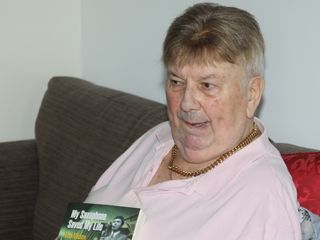Dealer who shot Dubliner dead in front of son didn't receive fair trial, barristers argue
Drug dealer Wayne Cooney, with an address in Tallaght, had pleaded not guilty to the murder of Jordan Davis (22)
Wayne Cooney
Barristers have argued that a murderer who shot dead a man in front of his four-month-old son did not receive a fair trial, as the trial judge effectively “closed down the defence case” in his charge to the jury.
Michael O’Higgins SC told the Court of Appeal that Mr Justice Tony Hunt was “entirely argumentative” throughout his charge to the jury at the conclusion of the trial of Wayne Cooney (34), adding that the judge argued “with great vigour” what the jury’s position should be.
Drug dealer Cooney, with an address at Glenshane Drive in Tallaght, had pleaded not guilty to the murder of Jordan Davis (22) at a laneway beside Our Lady of Immaculate National School in Darndale in Dublin on May 22 2019.
He also pleaded not guilty to possessing a 9mm semi-automatic pistol and to possessing ammunition in circumstances that give rise to the reasonable inference that he did not have them for lawful purposes. A jury took just a little over three hours to find him guilty following a trial in July 2022.
The prosecution case was that Mr Davis owed €70,000 to a local drug dealer, Robert 'Roo' Redmond, who was the brother of Cooney's then girlfriend, Rachel Redmond (34).
Rachel Redmond (File photo: Collins Courts)
When Mr Davis's mobile phone was examined by gardai they found a message from Robert Redmond (36) warning Mr Davis: "I'm on your case mate, it won't be long," and later telling him: "Soon, very soon, bang bang."
Rachel Redmond, from Coolock but with an address at Cliftonville Avenue, North Belfast, Antrim was convicted earlier this year on two charges that on or about May 22 and May 23 2019, she impeded Cooney's apprehension or prosecution by picking him up after the shooting and later checking him into a hotel.
Robert Redmond of Streamville Road, Kilbarrack, Dublin 13 pleaded guilty in April 2024 to conspiring with Cooney to murder Mr Davis and received a seven-year prison sentence.
During Cooney’s trial, prosecution barrister Bernard Condon SC told the jury that the circumstantial evidence against Cooney was such that he was either the shooter or the "most unlucky person ever".
A garda had identified Cooney from CCTV footage as the cyclist circling Mr Davis. Cooney's DNA was found on a glove in an area on Belcamp Lane where the shooter could be seen discarding gloves and a black body warmer minutes after the shooting.
Cooney was also identified returning to the same area to retrieve the body warmer about one hour and 20 minutes after the shooting.
Robert ‘Roo’ Redmond
The prosecution also relied on mobile phone evidence that showed Cooney's phone was calling Robert Redmond at moments when the person identified on CCTV as the shooter could be seen holding a phone to his ear.
In a lengthy charge to the jury, Mr Justice Hunt said that if they were satisfied beyond a reasonable doubt that Cooney was the cyclist who came up behind Jordan Davis and shot him, they must find him guilty of murder.
Mr Justice Hunt told the jury that if the prosecution failed to prove beyond a reasonable doubt that Cooney murdered Mr Davis, they could find that he impeded the arrest or prosecution of the murderer by taking away the body warmer.
He said that, by his own admission, Cooney was seen on CCTV at Belcamp Lane about one hour and 20 minutes after the murder.
He said the shooter disposed of the body warmer during a 40-second period when he was off-camera and when Cooney retrieved the body warmer, he also went off camera for almost exactly 40 seconds.
He said that the jury should consider that if Cooney wasn't the person who left the body warmer, he must have acquired some knowledge that it had been put there. He added: "If he didn't do the shooting, he acquired the knowledge of where the item was in that hour and 20 minutes. That has to be considered by you."
On this view, Mr Justice Hunt said, Mr Cooney wasn't the shooter but might have been "covering up".
He further told the jury: "If he didn't do the shooting, he didn't get to the laneway by accident.
There had to be some information that brought him there, he had to know something about what he was retrieving and where he was retrieving it from."
In launching an appeal against Cooney’s conviction today , Mr O’Higgins said that a judge is at liberty to pass comment on evidence, which is well within his ambit, but he should tread with caution.
“This is entirely argumentative through the whole charge. He’s not just summarising evidence, it’s strident, relentless, merciless and without any restraint,” said Mr O’Higgins, adding that Mr Justice Hunt had been “completely arguing with great vigour what the position should be”.
“The line beyond a comment has been very well crossed,” he said, going on to argue that the defence was “squashed” and never got the airing to which it was entitled.
Jordan Davis
Counsel said that in the judge’s charge, Mr Justice Hunt had reminded the jury that the defence had raised the possibility of the potential involvement of others in this offence, but he had also said to the jury that whether others were involved or not was not relevant.
“The judge said: ‘Who was the man on the bike? That’s all you have to decide.’ That was effectively closing down the defence case,” said Mr O’Higgins, adding that Mr Justice Hunt “denigrated all the points” made by the defence.
Counsel confirmed to the court he was arguing that the trial against Cooney was unfair. He said that Mr Justice Hunt had told the jury: “I won’t lie to you that I haven’t formed my own opinion.”
Mr O’Higgins asked how a judge was to charge a jury on the presumption of innocence when he had made a comment such as this.
“He said things pumping up the prosecution case. The judge highlighted in a very granular level all points that were in favour of the prosecution,” said Mr O’Higgins. “The judge has an obligation to deal with a case fairly. They must not, when giving a summation, end up with an imbalance between the parties.”
Further grounds of appeal submitted included the identification evidence given by a garda, which Mr O’Higgins said was too vague to be admissible; and attempts by the defence to adduce background evidence of other people who had a motive in the case, which were shut down by the trial judge, meaning “an important part of the defence case was cut off”.
Wayne Cooney was found guilty of the murder of Jordan Davis. Photo: Paddy Cummins.
In response, counsel for the Director of Public Prosecutions, Bernard Condon SC said that a lot of points were made by the defence during the trial which were “weak points advanced with gusto”. He said the trial judge was correct to advise the jury “not to be directed into rabbit warrens”.
“Arguments were made to direct the jury into evidential wastelands,” said Mr Condon. He said there were probably ten people involved in this murder and maybe other people wanted to kill the deceased, but that did not change the fact that it was Cooney who actually killed him.
“Some judges are naturally people who speak a lot, so it can’t be correct that because someone speaks a lot that they ought to be criticised,” said counsel, adding that the jury knew that the judge's commenting was not the last word.
Mr Condon also said that Mr Justice Hunt gave the jury an excellent summation on the principles of the presumption of innocence and the burden of proof.
Mr Justice John Edwards said the court would deliver its judgement on the appeal at a later date.











































